The Woman Waiting for Adulteryclipboard is a fundamental part of any modern operating system that even the least tech inclined are familiar with.
It is one of the greatest features the point and click interface brought to personal computers, and you don't need to understand the mechanics behind this invisible, temporary storage system in order to copy and paste your way through text, images, files and folders.
The act of transferring text from one part of a computer-based document to a different location within the same or different computer-based document was a part of the earliest on-line computer editors in the mid to late 1960s, though it was all command based.
Engineers at Xerox PARC later coined the names "cut" and "copy" for the first step and "paste" for the second step of the process and implemented it into several text editors, while Apple mapped the functionalities to key combinations consisting of the Command key held down while typing the letters X (for Cut), C (for Copy), and V (for Paste), widely popularising its use through the Lisa and Macintosh operating systems in the early 1980s.

Another factoid: Appropriately for this article, I copied, pasted, and edited bits and pieces from this Wikipedia page and this Quora answer to bring you that nugget of computer history.
The clipboard has evolved significantly throughout the years, but for all its usefulness, operating systems like Windows and macOS seem content with offering basic functionality and letting power users with more specific needs use third party clipboard managers.
The main use case for a clipboard manager is to keep a history of what you've copied and being able to keep dozens or hundreds of clips readily available for pasting as long as you need them, even after rebooting your computer.
They're useful when researching online to collect snippets of texts and useful URLs in a central place before organising your thoughts or anything you're working on.
A word of caution, though. While saving the contents of your clipboard to your hard drive for days, weeks, even years might be convenient it can also be a potential security risk if someone gains access to your computer. It's a good idea not to store passwords and other sensitive information in there.
With that said once you've added a clipboard manager into you workflow you'll see that they can be major time savers and can offer a big productivity boost, especially if you routinely have to re-copy snippets of text. Here are our favorite options in a few distinct categories for both desktop and mobile.
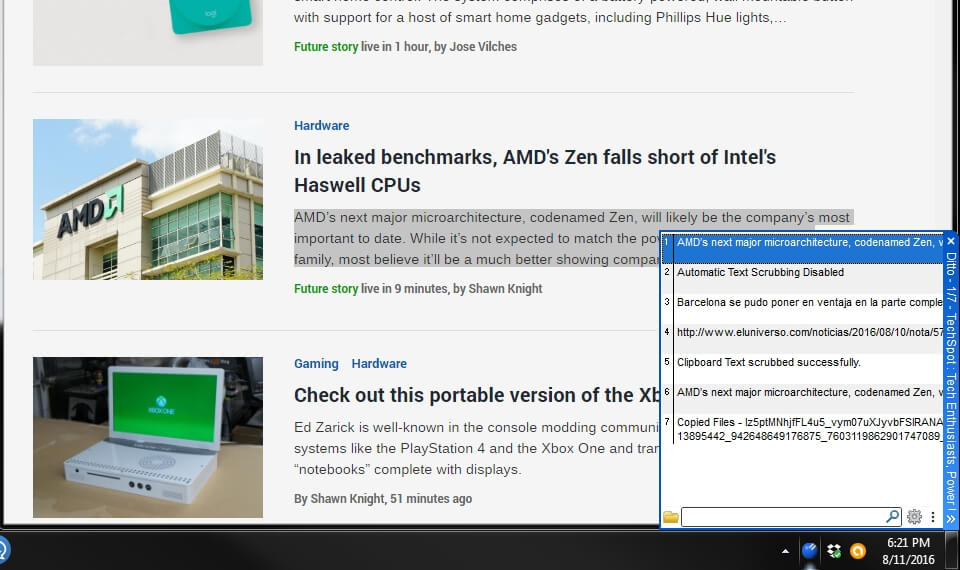
Ditto has been around for years and still ranks among the best clipboard managers for Windows. It's simple yet powerful, fast and light on resources despite packing a decent amount of features. You can sort your clips into groups, search for specific keywords through its ridiculously long history, and make use of multiple hot keys to make copying and pasting. Ditto supports files, images, and text and offers encrypted, cloud-syncing for using a single clipboard across multiple computers.
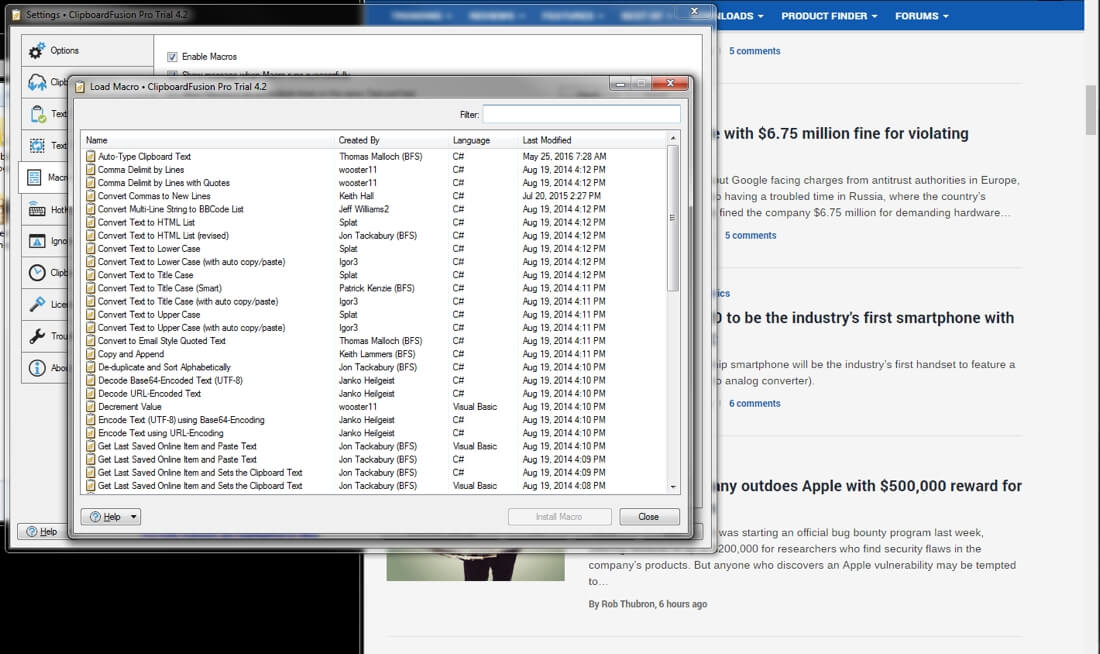
ClipboardFusion is another simple but powerful clipboard manager that's actively maintained so it'll work well and won't look outdated on the most recent versions of Windows. It's headlining feature is the ability to scrub text copied to the clipboard so that it can be pasted into different applications without formatting – it can be done automatically or with a customizable HotKey so you can retain formatting if you want to.
It also comes with a text replace feature that allows you to easily find and replace all instances of a specific text string in your clipboard manager. A preview feature to get a quick glimpse at clipboard images and color coded HTML with a toaster pop-up, and has full support for macros to perform completely customized transformations on your text.
ClipboardFusion is free to use but offers a paid subscription for advanced syncing features across multiple devices – including Android and iOS.
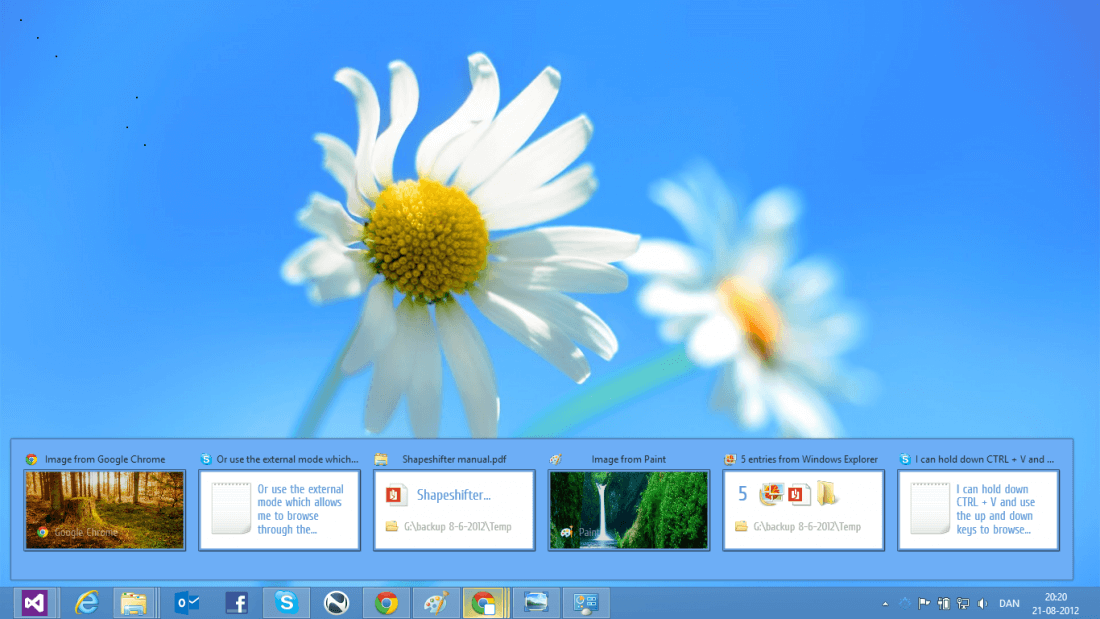
ShapeShifter is more of a clipboard extender rather than a full fledged manager as it just takes the native clipboard functionality and makes it more capable without adding too many bells and whistles.
One key difference next to other clipboard managers is that Shapeshifter stores clipboard contents in memory instead of the hard drive, so while you can have multiple clippings readily available, everything will be cleared when you restart the computer. If you want the convenience of a more powerful clipboard but don't care about fancy features or keeping months long history of clippings, this one's for you.
ShapeShifter supports files, text, and images and sports a modern dock-like interface. Unfortunately development came to a halt a few years ago so Shapeshifter doesn't play well with Windows 10. A new open source version currently in beta is being written from the ground up but it's still very buggy and we're not sure if it's being actively worked on.
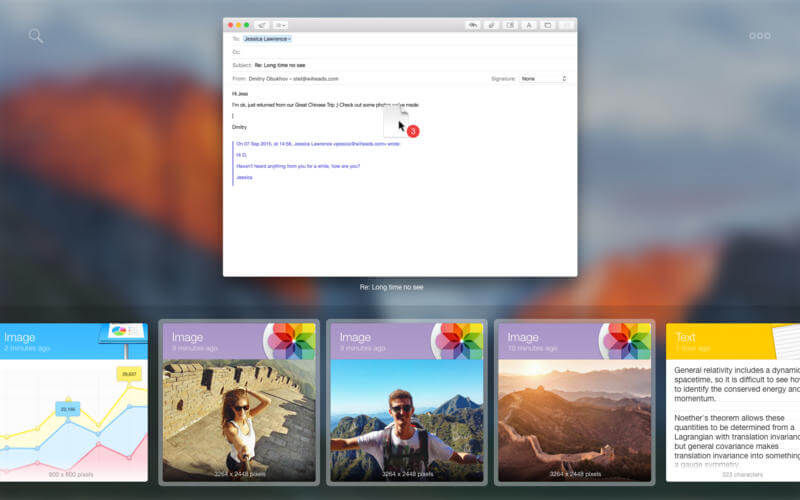
Paste is an impressive clipboard manager that uses a colorful interface with large previews to make it easy to identify the item you want to paste. It'll automatically add anything you copy to its clipboard history, which you can access though a keyboard shortcut or the Paste icon in the menu bar.
By default it'll keep the last 100 items on the clipboard but you can can configure this number all the way down to 10 and up to unlimited. There's a powerful search function that's especially handy as your number of snippets grows, and besides searching for text within a clipping it can also find file types such as 'photo' or 'video', for example. Paste also offers Pinboards, which are effectively folders that you can organize your snippets into, such as code snippets, and URLs.
You can setup rules so that Paste doesn't save anything that's copied in certain apps. By default, it doesn't store anything copied from Keychain Access, and it will recognize if you use a third party password manager and automatically exclude that, too.
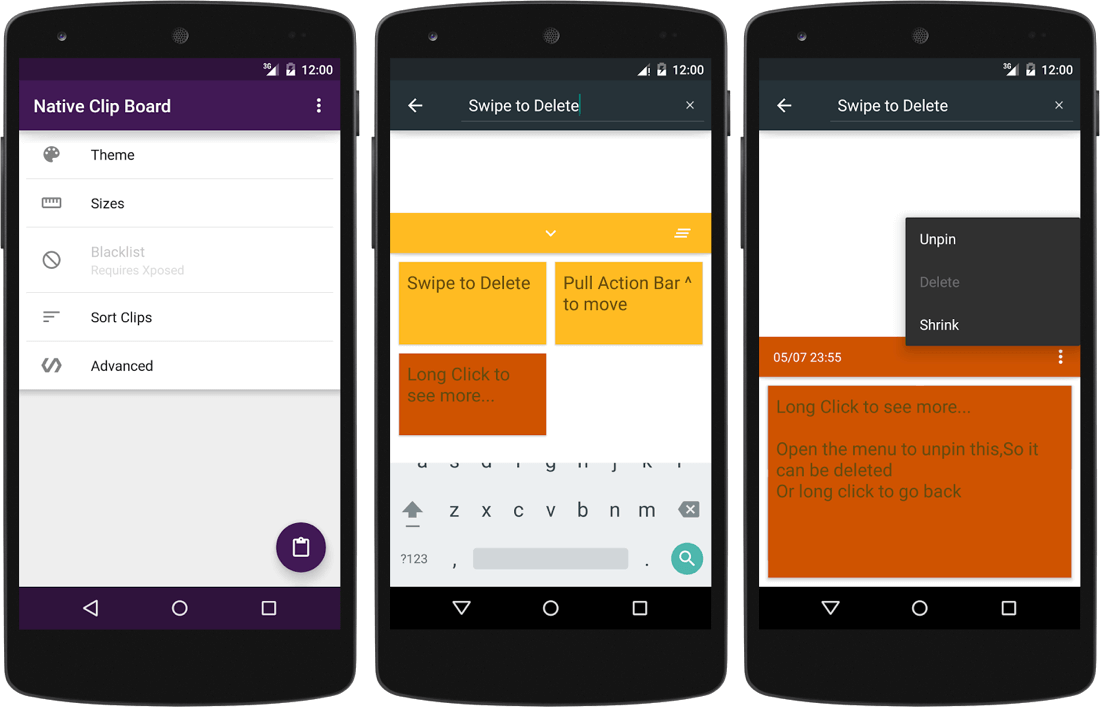
Native Clipboard automatically saves everything you copy onto the clipboard and gives you tools to easily manage things. It has a handy floating interface that's summoned by double-tapping on any text field. From there you can insert the text you're looking for, swipe on one of the saved copies to delete it, or long-press it to pin it to the top of the list if it's something you think you'll need often.
Native Clipboard uses a Material Design UI that can be customized to your liking. It's also free and open-source, compatible with Android 4.0 or later. You will need to give it access to your accessibility settings for the double tap functionality to work properly.
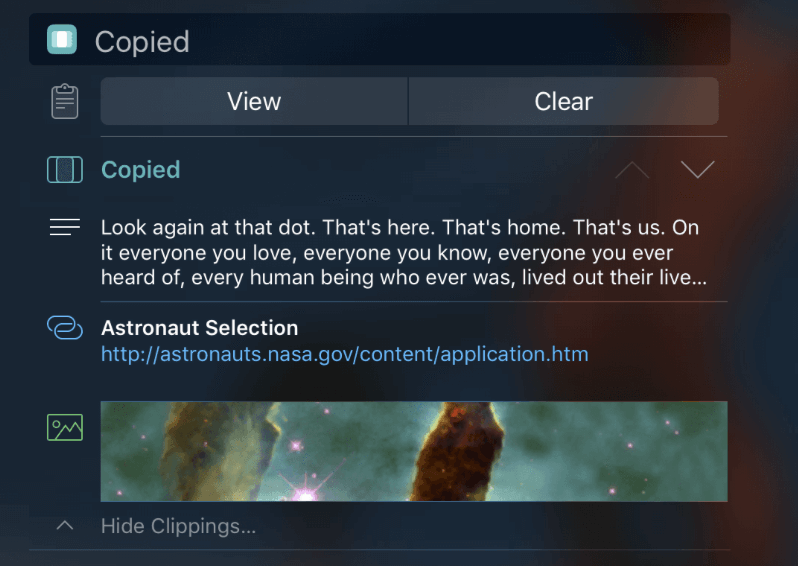
For those with an iPhone, Copied is a clipboard manager for iOS that keeps track of everything you copy, lets you easily edit clippings, share links and text, and has an excellent batch feature. The app offers a handy Today Widget for fast access to clippings, and if you choose to enable auto-save, what you have in the clipboard will be automatically added to Copied as soon as you open the widget.
Clippings can be copied and saved from any app with the iOS Share Sheet and you can use the Copied Keyboard to input saved text into other apps. Copied is also available on iPad, has a more feature packed macOS version and you can keep everything in sync with iCloud.
 Character AI reveals AvatarFX, a new AI video generator
Character AI reveals AvatarFX, a new AI video generator
 Extreme fires erupt in the Arctic Circle
Extreme fires erupt in the Arctic Circle
 Tina Fey, NBC ask to have 30 Rock episodes featuring Blackface pulled
Tina Fey, NBC ask to have 30 Rock episodes featuring Blackface pulled
 Soon nearly any influencer will be able to sell stuff on Instagram
Soon nearly any influencer will be able to sell stuff on Instagram
 The 5 most inappropriate things Donald Trump said at a Puerto Rico disaster briefing
The 5 most inappropriate things Donald Trump said at a Puerto Rico disaster briefing
 Tom Petty's family demands that Trump back down from using a hit song
Tom Petty's family demands that Trump back down from using a hit song
 Elon Musk just made a dick joke
Elon Musk just made a dick joke
 Soon nearly any influencer will be able to sell stuff on Instagram
Soon nearly any influencer will be able to sell stuff on Instagram
 Elon Musk makes request to Reddit CEO to take down posts he didn't like
Elon Musk makes request to Reddit CEO to take down posts he didn't like
 J.K. Rowling reveals exactly what she'd like to happen if Trump visits Britain
J.K. Rowling reveals exactly what she'd like to happen if Trump visits Britain
 SpaceX's Starlink satellite launch in pictures
SpaceX's Starlink satellite launch in pictures
 Manchester Redditor shares heartwarming gift from Muslim neighbour
Manchester Redditor shares heartwarming gift from Muslim neighbour
 Apple unveils iPadOS 14 with search and Apple Pencil upgrades
Apple unveils iPadOS 14 with search and Apple Pencil upgrades
 Elon Musk reschedules Tesla 'Battery Day' for later this year
Elon Musk reschedules Tesla 'Battery Day' for later this year
 Finally, there's an app to help you decode your match's messages
Finally, there's an app to help you decode your match's messages
 Jenny Slate will no longer voice a biracial character on 'Big Mouth'
Jenny Slate will no longer voice a biracial character on 'Big Mouth'
 Ariana Grande's mom was spotted comforting fans during the Manchester benefit concert
Ariana Grande's mom was spotted comforting fans during the Manchester benefit concert
 Tim Cook calls out 'senseless killing' of George Floyd in WWDC opening remarks
Tim Cook calls out 'senseless killing' of George Floyd in WWDC opening remarks
Celebrity conspiracy theory: Marisa Tomei wasn't supposed to win an OscarHow to fight social media anxiety in the Trump eraYes, 'Game of Thrones' fans, you'll get something from George RR Martin this yearJ.K. Rowling has the perfect response to Trump trolls burning her booksBeyoncé's pregnancy photo destroyed an Instagram record because of course it didNew space pics show off the greatest kitten toe beans in all the universeMum makes Prince George sailor outfits so your child can dress like the future kingHow Facebook is trying to dominate mobile without owning your smartphoneTrump's short Black History Month speech was mostly about himselfBeyoncé's pregnancy announcement will save America, at least according to TwitterSamantha Bee compared Donald Trump to Paris Geller from 'Gilmore Girls'Leaked video shows 'nightmare inducing' robot from Boston DynamicsGoogle's Waymo selfThe most absurd announcement videos from college football's National Signing DayFacebook is within reach of 2 billion usersOf course this novelty 'Final Fantasy' fork is an oversized sword replicaCelebrity conspiracy theory: Marisa Tomei wasn't supposed to win an OscarHow to fight social media anxiety in the Trump eraNation's largest network is down and everyone's making a Trump jokeCelebrity conspiracy theory: Marisa Tomei wasn't supposed to win an Oscar Francine du Plessix Gray and Sorrel Soup by Vasily Rudich and Gabriella De Ferrari The Teddy Bear Effect 'Fat City,' Fifty Years Later: An Interview with Leonard Gardner A Darker Canvas: Tattoos and the Black Body Poetry Rx: Valentine’s Day Edition by Kaveh Akbar Daddy Issues: Renoir Père and Fils by Cody Delistraty The Most Widely Unread Book Ever Acclaimed Meeting Eve Babitz by Lili Anolik A Loss Like a Knife: The 2019 Australian Open by Rowan Ricardo Phillips Three Writing Rules to Disregard by Benjamin Dreyer Staff Picks: Decadence, Doodles, and Deep Ends by The Paris Review Mars may have harbored a shocking amount of water, scientists find Mercilessness Clarifies: On Bernard Malamud by Chris Bachelder When Diderot Met Voltaire by Andrew S. Curran Revisited: Watership Down Inherited Trauma: An Interview with Emily Jungmin Yoon by Lauren Kane The Truth About AI: A Secular Ghost Story by Zachary Mason Selika, Mystery of the Belle Epoque Anni Albers’s Many Element of Sacrifice: An Interview with Maurice Carlos Ruffin by Peyton Burgess
2.6281s , 10158.40625 kb
Copyright © 2025 Powered by 【Woman Waiting for Adultery】,Fresh Information Network